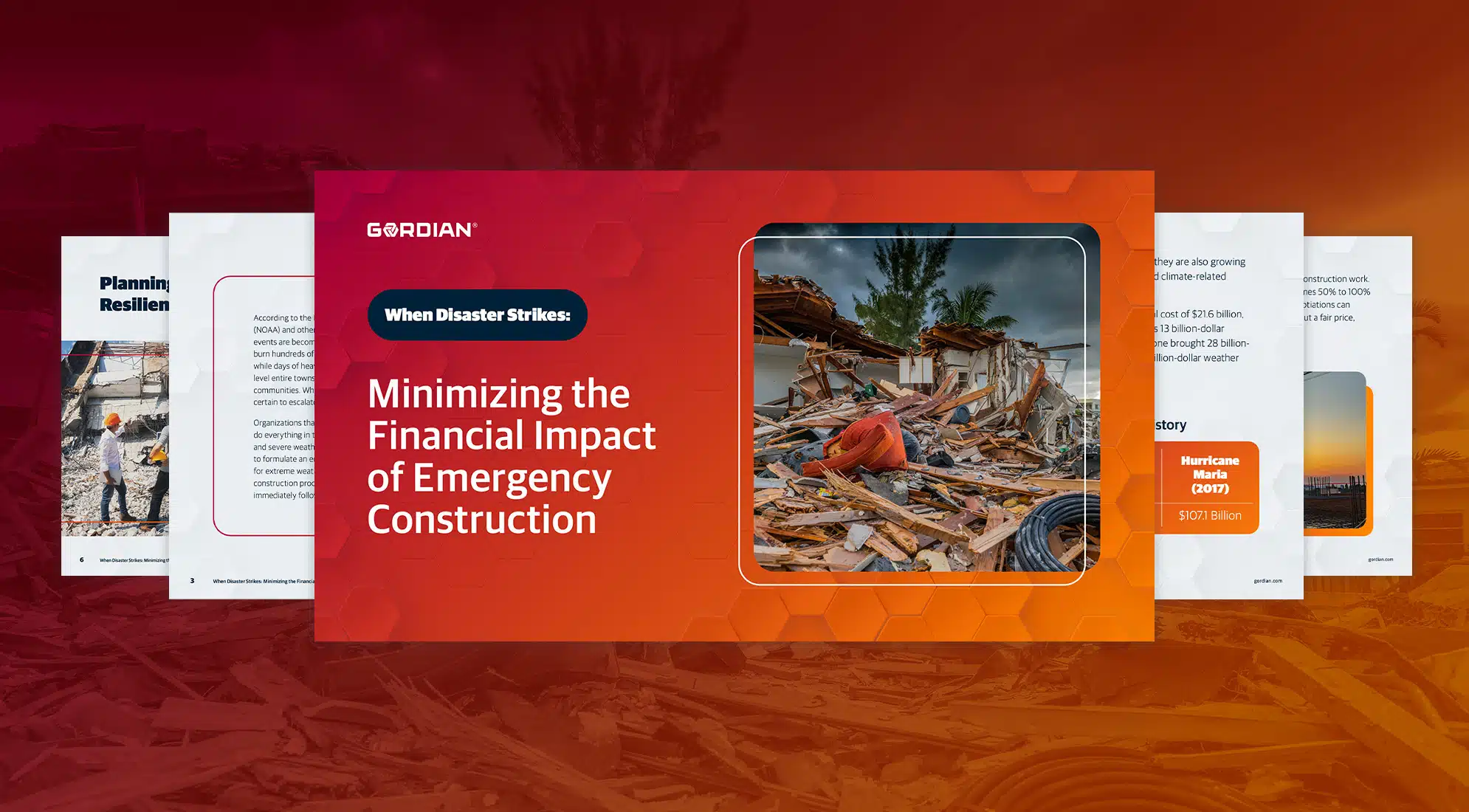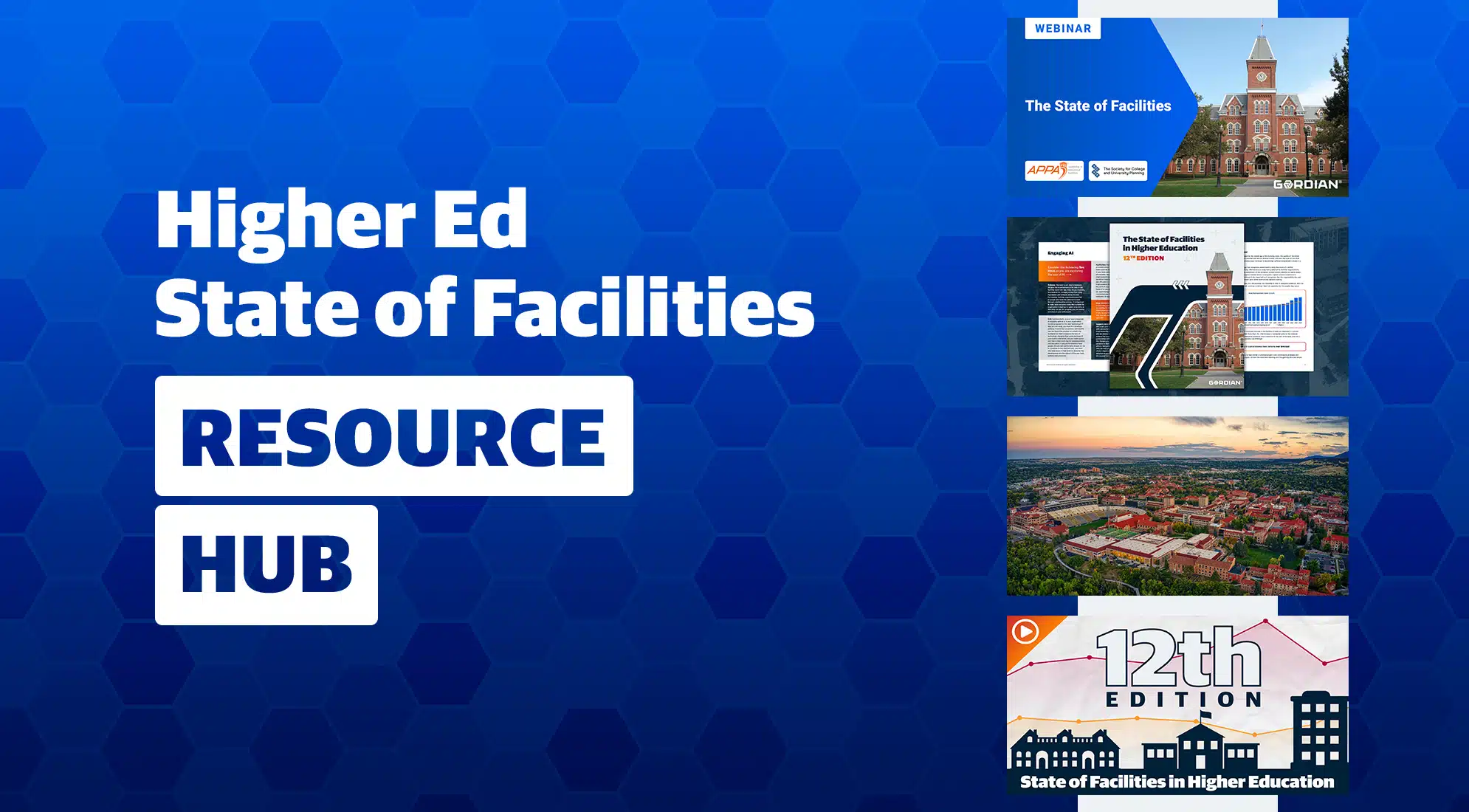
State of Facilities Conversations: Episode 1
June 12, 2024
Pete Zuraw: Greetings to all who are listening to our series of conversations on the State of Facilities in Higher Education. My name is Pete Zuraw and this is actually our inaugural conversation, our first, to explore issues and ideas related to this year’s 11th annual report. We encourage anyone who hasn’t seen the report to grab a copy available on the Gordian website. We intend to use this series to really go beyond what is in the report to talk about where the observations in the report lead us and how it connects to the future direction of colleges and universities, and particularly their leaders. Like every interaction here at Gordian, we hope to support you today in your work building better communities by transforming data insights into smarter decisions. I am absolutely thrilled to be joined by my colleague Jon Burbee. Welcome, Jon.
Jon Burbee: Thanks, Pete. It’s really great to join.
Pete: Can you share briefly your background and what you do here at Gordian?
Jon: I break it into two primary chapters, the first 23 years, where I was a construction engineer officer in the Canadian Forces. So looking after Air Force Base infrastructure in Canada and while deployed and what I call that next chapter was 11 years as a public servant. So mostly in the built environment with National Defense and managing the portfolio for provincial governments – courthouses, correctional centers, office, buildings, that kind of thing. And the interesting part was the last stint was out of the built environment and services. So really got exposed the digital services and the opportunity using data to improve business operations. For the last year and a half as the director for business development in Canada, I’ve taken a role kind of like an ambassador where I both represent the company to our customers and the market. And I represent one perspective of a customer or end user inside of Gordian.
Pete: Before we get into the meat of our conversation, I guess I should note that you mentioned nothing about higher ed in that in that description, and this is a podcast about higher ed. I happen to know about that curious mind of yours and have been the beneficiary of those insightful questions you routinely pose and helping me thinking about what I’m doing more efficiently. But you want to offer maybe a couple other thoughts about why anybody should keep listening to us today in the conversation.
Jon: Other than our highly dynamic interpersonal rapport, there’s lots of reasons, but I think I think you see most will recognize that most of my experiences related to leading the support and the institution that has another purpose beyond facilities.
Facilities is really never the primary purpose. It’s about the mission.
It’s about educating, providing higher education, providing National Defense, providing what have you. And it’s about having pride in that supporting role both for the success of the organization, but really being part of the supporting cast when taking great pride in it.
I should mention that I had a brief close encounter with higher education when I was the base engineer at one of our training centers in Ontario. I was 30 with a young family assigned to this. One of the best jobs I ever had, it was large organization, public works, buildings and we supported all the support occupation schools, so military police and aircraft maintainers, even chaplains and dentists. In addition to hosting 10,000 residents, including students, families, supporting staff who maybe lived on base, wasn’t terribly unlike looking after faculties and the student services organization. So I can kind of relate multiple funding variety of asset classes, multiple priorities. I hope some of what we talk about today is relatable and we can make the analogy to their own context.
Pete: This whole notion of service to a community and trying to support that community, connecting to that mission, I love that you’re tying in all of those different pieces. I’m hopeful that…this conversation will be able to link into some of those other experiences you had. I think anything we do here in the Gordian planning work, we talk about the fact that there’s no singular piece of information or point of view, frankly, that’s enough to fully understand the challenges we’re facing and certainly no single point of view can help us really determine the best possible moves forward, as individuals or an organization.
I’m going to open up the conversation instead of asking you to reflect on what we shared in the State of Facilities this year and maybe as a quick reminder, that was information about enrollment and space challenges. It was about investment and operations and capital efforts. It was a discussion about potential service declines we’re seeing post pandemic and really also a kind of a deep dive about the challenges to find talent instead of me speaking about all of that, I want to ask you what, if anything you observed about it in the report that we could have spent more time on and that you think is more important that we didn’t talk enough about.
Jon: First of all, I gotta say, it’s such a great report. I’ve always admired it.
Wish there was a similar benchmarking that went on for all the other sectors, and that’s a great thing about this public or quasi-public world we’re in is sharing is a superpower of people in service of society. I think one of the areas was probably relating to backlog, backlog and deferred maintenance. I know we got into that, touched on it there.
You can only focus on so many things, but just how it represents a degree of risk and how planners and managers really have to look at that as a risk management exercise. So going back to using an analogy in Canada, there’s cyclical reports collecting the condition of public infrastructure and the impact of deferred maintenance and they haven’t cost it so much but really rated it as poor, very poor and the results are staggering as we continue to grow, mostly through immigration.
Nearly 40% of the roads and bridges are in fair, poor or very poor condition and about 80% or more than 20 years old. 30% of water infrastructure is fair, poor or very poor condition. And so that’s not only introducing health and safety risks, but just, can your functions continue? And depending on the accounting practices that are used in some cases, if they used international financial reporting standards, that actually shows up on the books and impacts [the] ability to attract borrowing and investment.
Think about the safety and operational [and] reputational risks that are associated with it. I’m a parent of two daughters who go to different higher education institutions, and I expect them to be safe there. I have friends who are on faculty or support staff, and I want them to be supported to do their best too. So I guess having a look at the backlog would be really interesting to…understand. How do we move forward from there? It’s to inform other decisions, and often it’s about attracting more funding, but these days, which maybe we’ll talk about more is well, what else? Where else can you best advise the organization to turn to deal with this backlog?
Pete: I think that’s a great point, and we need to bring it up more. We didn’t float the backlog number this year simply because we were still waiting for more data to come in and that data, you know things are things been a little delayed post pandemic in terms of people getting their reports in and just gathering the data and information.
But I mean the number last year we reported was around $130 per foot and that number right now is looking like $140 this year. So as soon as we finalize that, we’re gonna, we’re gonna put that out.
We’ll probably do a little supplement, but I think that’s great.
You’re absolutely right, I mean, there have been stories about pieces of buildings literally falling off, right? Not just impacts to program, right, impacts to research, maybe as leaky roofs, those kind of things, but literally structural failures, and we need to make sure that we stay focused on it. I think it’s a huge issue and it at $140 a foot. That’s nothing compared to what it cost to put a new building up, right?
In terms of investment, reprioritizing makes a lot of difference, but it’s still hard to get that money dedicated for something as mundane as fixing a leaky roof or replacing a mechanical system. At least in the States, there’s just not a lot of interest right now in spending money on that, unfortunately.
Jon: I mean, it’s common and I know you and I probably spent much of our working lives pointing to the deferred maintenance and showing objectively why we need more money. I was talking to a senior executive working in a public space recently.
They said that the number became so big, we actually just kind of started turning it off because we’ve been saying ourselves, it’s gonna fail. It’s gonna fail, and sometimes it does fail or you have a catastrophic boiler failure or something, but it’s not always as catastrophic as we may indicate, so that may still need to be the case.
You’re trying to track more funding, but I’ve seen it where we’ve used it to make the case to dispose of underperforming assets – so decommission a building, demolish it, sell it, stop leasing it, repurpose it. That backlog information can inform additional information because you know, as senior leaders in the institution, yes we lead facilities teams, but we’re also partners and leading institution and sometimes attracting more funds to get at that deferred maintenance may not be the greatest need for the institution. So how do you work through that? But just you’re starting with accurate information and a quantified information.
Pete: You’ve touched on a few things that…really shine to me. One is that issue of always asking for money because we need something, because it’s broken. Right there is a proven failed strategy for getting cash, and it loops back to what you talked about at the very beginning – linking the work to the mission. Linking the work to the mission, setting priorities based upon what it is, whether it’s the military base or the higher educational institution or the municipality, trying to find a way to make clear that the investments need to be made in the places that are most important to the mission. And sometimes that does mean letting something run to failure, sometimes letting something run to a declined state and maybe decommissioning the system or the building. I think that’s a really important issue, because it’s gotta be tied to mission, not just keeping everything pristine because it exists, which as facilities professionals we can sometimes get caught up in, and it’s not helpful to the to the mission of the organization.
But that second piece really ties to this question of space, right?
If we if we maybe step in a slightly different direction and talk about space, the backlog indicates that we need to invest in spaces we have, and soon, if we’re gonna keep them operating effectively. But post pandemic, there’s a real lack of clarity on the need for those spaces, you know? And I guess I’m wondering what your thoughts are on the space question? Can you decommission it in general? And are there any insights that are, I don’t know is the world different from a few degrees latitude north in terms of different ways to think about how we might use or decommission or repurpose space?
Jon: Yeah, it’s a great question. And I think many were thinking of it even before the pandemic where it really served as an inflection point. I use an analogy that you can only have so much nutrition to feed the massive bodybuilder. And what we’re really trying to support, what we actually can afford, is an endurance athlete with a smaller frame, a smaller body mass and what have you. And so I think that’s always been trying to match the available operation and maintenance funding to the portfolio that we have with the pandemic and with being an inflection point. And it’s really not the same conversations that are happening with office space and commercial retail space. It’s just the opportunity to do things differently, right? And so to my surprise, when I went to the Ontario APPA conference last year, I really got to hear that that next layer of detail cause, you know, the initial assumptions going in was, well of course, it’s time to reduce space. You were able to run a university without a physical space for a little while, so let’s adapt, but you get into things like,
conditions tied to grant funding or collective agreements for faculty that entitles them to dedicated office space, regardless of the time they spend it. Maybe worth a deeper dive, yet great data on there, but maybe there’s a deeper dive on different types of use in in campus or what have you just to have that benchmarking again to inform the conversations within the institution.
Pete: No, I was just going to say, I mean, you’re right that that our data in the report talks about the leveling off of space there where we’ve been talking for a while about the ongoing space creation even though there wasn’t necessarily the population in front of the pandemic to warrant it – a bit of a build it and they’ll come attitude was kind of playing out and it’s still leveled off. I think to your point, because institutions have recognized that they need to be able to afford to operate what they own and many of them were well beyond being able to do that. So I think that’s great, but it is an interesting question going forward. What other signals are gonna help us make the right decisions? And it is fascinating. I think it’s institution to institution, right?
The Ontario apple is going to be very different than an apple happening in Arizona or Nevada. And in terms of what’s going on in California or Texas having everything just growing like crazy. So I think it’s interesting to think about, and also even issues like faculty stipulations on office space, right, there are assumptions, but they’re they’re literally in some places stipulations versus some communities where there’s no requirement at all. So the solution I think to your point has to be tailored to each of the circumstances.
Jon: And I think there were some faculty attending the last APPA conference that…I think most people are reasonable if they walk around and they see floors of empty space and empty labs. They all recognize that needs to be tempered like heated or cooled. It needs to be clean. Needs to be lit and it’s wasteful, right? So I think I think there’s opportunities there and now’s the time and we’ve proven the extreme case in many cases where they had to close down campuses.
Pete: There’s an implication in what you’re saying that there’s a correlation between people thinking about things and the amount of resources that are available and where are you thinking we’re headed with regard to investment generally, do you and thinking, particularly in spaces that are for, I’ll call it a civic purpose, right?
You’ve talked about you working the public sector and I think of colleges and universities having a civic purpose, right, whether they’re public institution or private, right? Where do you think investment is headed it or what are you seeing from where you’re sitting about investment in those kinds of things?
Jon: Well, it loops a little back to the deferred maintenance.
I mean to get at some of those savings, of course you’re gonna need to consider investments in terms of tenant improvements to existing space to just change the way it’s being used. Maybe some work required to modified assets that are being disposed of, or to refit buildings for consolidation. There’s also thinking about it differently and I have seen some post-secondary institutions adapt to lease the space like to let communities use it for a fee. And especially if there’s limited hours or there’s other revenue generating options that may require some investment.
So it’s kind of counterintuitive to save some or to catch up on that deferred maintenance by reducing your portfolio; there will likely be an initial bump to modify those institutions.
Pete: I mean, I’m certainly seeing tension here, particularly in the public realm where, for example, public university state legislatures have been pulling back on the resources for them, driving requirements for increased tuition or other kinds of, to your point, other kinds of revenue streams. It feels to me like that’s a battle that’s happening in part about trying to prioritize missions, right? Trying to prioritize where the money should be spent. Where the states are notorious for all of our money spent on the military, right? The exclusion of other civic offerings and there are debatable good and bad reasons for all of that. But that’s very familiar. And you see that at the state level too, where you see battles to deal with other kinds of services that the states are delivering for those tax dollars. And I guess I’m wondering, are you seeing the same sort of tension there in Canada?
Jon: Oh, absolutely. I mean, I know there’s differences in funding and with your private institutions scenarios, but in in Canada, a large portion of funding does come from the government, but they’re expected to generate their own through grant research grants through tuition. And then pressure to reduce the cost of tuition.
And so one of the one of the routes to make up a funding gap, and it was explicit direction in many jurisdictions, is to make up the difference by attracting foreign students who could pay a premium. That was a big part of the business model, right?
Other parts of society with pressures on housing, you know, other factors, and frankly, some bad actors for post-secondary institutions where they were really weren’t actually delivering high quality education, that there’s introduced a cap in enrollment on foreign student population. So, now they’re in a catch 22. Here’s the money we can give you. Go make up the rest by doing a really good job to market yourselves in the world market. But then we’re gonna reduce the number of student visas so that that is a big issue, especially in some jurisdictions. In fact, it’s in some cases it’s a matter of survival. There is one major institution that filed for bankruptcy in 2021, so under protection, and it’s pretty tenuous right now and an area of concern that I’m really keeping my ear to to hear how that develops.
Pete: Interesting, right?
Something we’ve talked about the last several years in these reports is this notion that when funding constraints happen and population constraints, right?
Well, in the States we’re talking about this demographic cliff that’s coming in 2026.
We’re going to see the birth rate decline that’s been happening since 2008 impact the declining available student population for higher education. And then just the general revenue stresses and there’s never been a situation historically where that has an impacted the facilities budget, right? So even talking about the growing backlog and everything else, all those pressures inevitably yield impacts there because it’s such a big component of operating these institutions. And even though we did successfully operate them quasi virtually for a while, people seem to want to be together. They want to be on campus. They want to be part of that community of learners and thinkers and investigators. And so it’s really interesting to see that tension. It’ll play out and it’s gonna be hard.
One of those constraints has also been on talent and finding people. We talked about that a bunch in in the report this year, the challenge to find people who want to do the work or have been training to do the work. Significant shortfall projected. We will need in the States like another half a million plumbers by 2027 that aren’t out there right now in order to just to get stuff done. As much as we talk about the digital world, we still need the pipes going in and out of our houses and our buildings for lots of very human reasons, right?
So I guess I want to ask you a little bit about challenges you’re hearing about in finding facilities professionals at all levels.
Jon: Well, it’s very, very similar. And I pay a lot of attention in my daily industry scans about numbers on labor, skilled trade availability, building professionals availability. It has a big impact in facilities shops in terms of employees, contractor availability of course, that impact economically in terms of the price, staggering numbers for just retirements but also people exiting the career field midway. So there’s a big impact on prices that we’re seeing, impact on contractors even showing up for a bid. I love the fact that this latest report spoke to that because that’s such a big part of being able to execute the work that’s needed. In areas that I was familiar with most of the time we’d see entrance to skilled trades either right out of high school, get their apprenticeship, or maybe they were in a labor shop and they wanted to get a red seal trade. And so they kind of upskilled, so that that was one pattern. The other one was those that had worked in the private sector or maybe oil fields or what have you. They were kind of looking for a change in what they valued; they made their money, now looking for some stability, maybe looking to access a pension or greater health and safety, whatever. So those were the two, fewer lifers I started to see, people who would spend their whole career in an institution.
What’s really fascinating is a lot of effort from construction associations and trade associations about making investments in leadership, having better leadership because many frankly, many workers seem to be departing the trades because it’s already a tough place to work because some of the physical demands, but some of the workplace cultures, frankly, don’t haven’t had the best reputation.
I mean, I play on hockey teams filled with people I used to work with in the trades and you know, it’s almost a badge of honor that you’re hard on the apprentices when they come in and you’re gonna be broken by the time you’re middle aged.
A lot of work with construction associations recognizing that part of the reason for the drain is because there are more attractive work environments and so there is some really progressive work to improve that environment.
Good leadership, welcoming women in trades, etc.
And just the safety culture.
So that’s been really, really positive, but it is an issue.
Pete: I love that last point. APPA has started to run a program where they’re focused on sort of social development, coping with stressful environments, helping people coming through learn to understand what it means to work with these communities. And I think to your point, also reminding the leaders and managers to make sure that they’re fostering those kinds of healthy environments, I think is a byproduct of that exercise because we’ve done a lot of time, in theory, helping leaders grow. But we don’t always focus that same amount of energy and helping the people coming up grow. And if we want them to aspire to be leaders someday and see it as a welcoming place to work, whether they’re coming, whether they’re early lifers, are getting tired, or they’re coming in from somewhere else, you want to create an environment, you want to create a culture that is socially acceptable in these communities. I think we talked in the report about some of those things were talking about. You’ve got to look farther and harder to find people and you really need to be prepared to kind of develop your own talent pool because it may not be coming from someplace else. And then you have to invest in the development of people and it’s going to take effort and it’s going to take time and it’s going to require investment. Whether that’s financial investment or just human investment, it’s going to be significant.
Jon: Just to build on that a little, because a thought came to mind, that it’s a real opportunity with this community in two tangents. One is a bigger tangent and that’s maybe introducing the conversation to the broader the research community about is there is there a social science avenue someone may want to pursue about what would make it better or what could attract people to the to the professions and skilled trades that we need. Another one could be on workplace, there’s probably a whole research bent about and it could be counterintuitive because you’re, you know, sometimes discouraging people to pursue an academic group versus a more vocational route.
Pete: Well, that’s one of the ironies right now is that for 60 or 70 years, we’ve been convincing people that going for a higher education is a really great thing because long term earnings are better and everything’s going to be nicer. And what that’s meant is we’ve taken a lot of people out of the electricians and plumbers pool and made them accountants, which is fantastic, but now we need electricians and plumbers.
Jon: The second tangent may be to have to have higher education institutions be looked at as an employer or a business partner of choice. I think contractors and individual workers have a lot of mobility. They can work in commercial space and housing. There’s a lot of different places to work, but if post-secondary institutions can be excellent business partners and an owner of choice in a contracting scenario or an employer of choice, it’s always hard to compete financially, but there’s so many other benefits. I know when my sister-in-law worked in the admissions office, my brother got free education or there’s access to gym or there’s just being a great place to work on a variety of assets. So there’s a lot of other ways that institutions can still be an owner or a business partner of choice, because there’s a lot more mobility for contractors and individual trades people.
Pete: I do hear the squeeze on some of those benefits of working in higher ed.
But I do agree that as we talk to people over the last year plus about this issue, they were speaking to this issue of this idea of trying to continue to make the work environment appealing.
I had a guy working years ago, he came in temporarily off the contractor site and he was working in a January time frame for us and just doing some work.
I was short some people in for whatever reason and I asked is this OK?
Are we creating a good environment for you? And he looked at me funny like no one ever asked me if I’m creating a good environment for you.
So that was a good sign, and he said, “I could be out of the local amusement park in the snow and building the new roller coaster, or I could be here with you helping fix student issues. I’m just fine. Thank you.” So I think celebrating those kinds of characteristics of these places, I think you’re right is a really important element of this and it’s going to vary for institutions obviously, but I think it’s a really, really good suggestion.
This has been awesome talking with you, Jon. I thank you for joining and thanks to anybody who is listening to us at this moment.
As I noted right from the very beginning, this is the first in this series we started this summer and I’m really delighted that you’ve been the one to help us kick this thing off.
I want to ask anybody who is listening to this to keep your eyes peeled for more conversations in which we’re going to speak to people a little more deeply on the staffing challenge. We’re going to hear from some finance officers about how they’re thinking about the future and some of those stresses. We’re going to talk to some association leaders about what their communities are thinking about and what will be necessary, in this community, is to really change how higher ed confronts and meets all of these challenges.
So I think this has been a fantastic kick off and I really, really appreciate you joining me for this.
Jon: Thanks Pete. It’s just a real pleasure and it gives me lots to think about.
Pete: Oh my gosh, it’s so much fun.
So thank you to everybody for being with us.
And until next time we do hope that you too are focused just like we are on transforming data insights into smarter decisions that will aid you in building the best possible communities.
All right, goodbye.
Share this:






